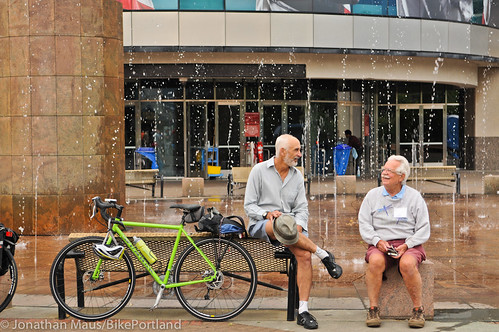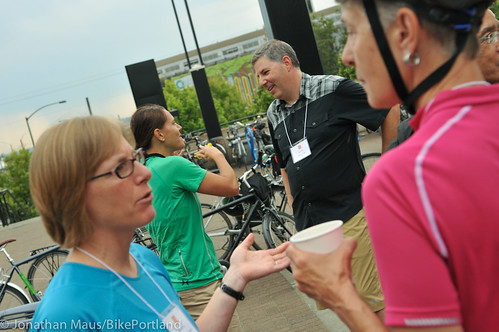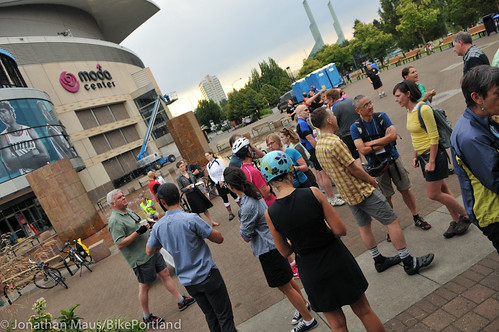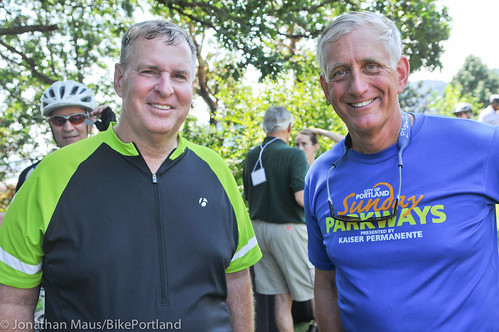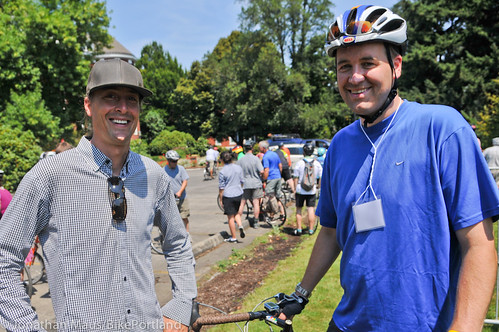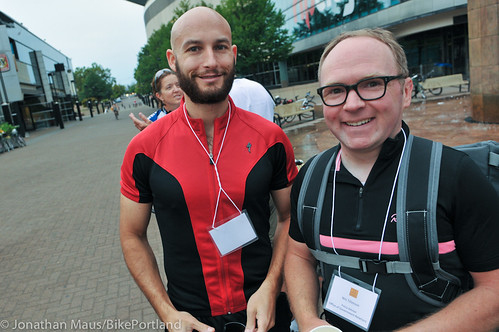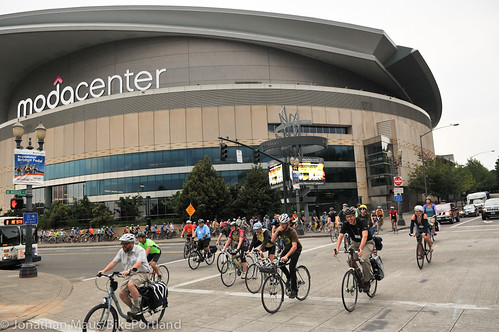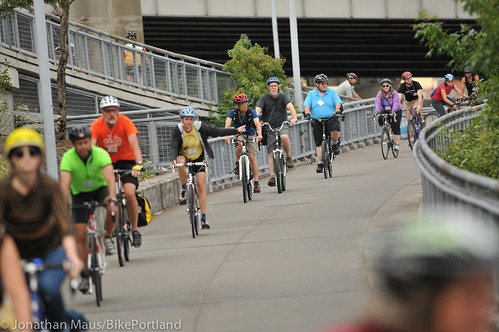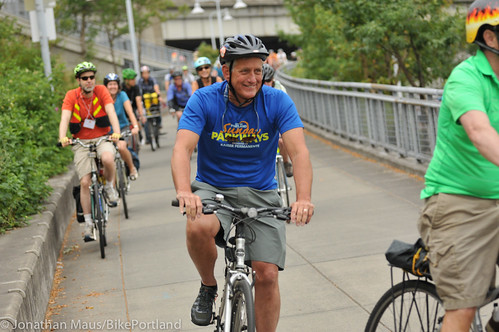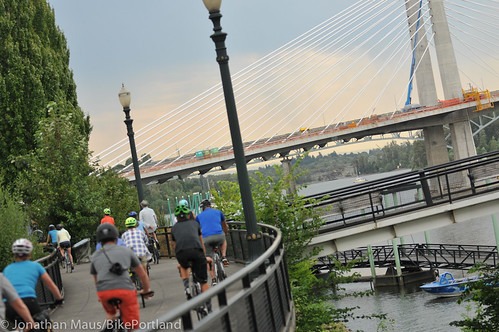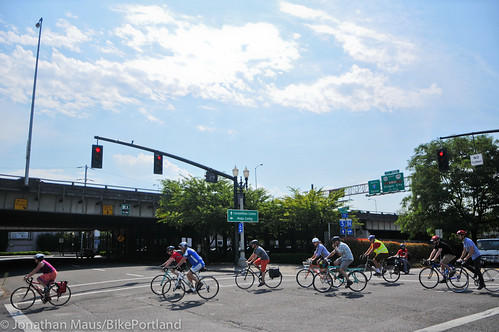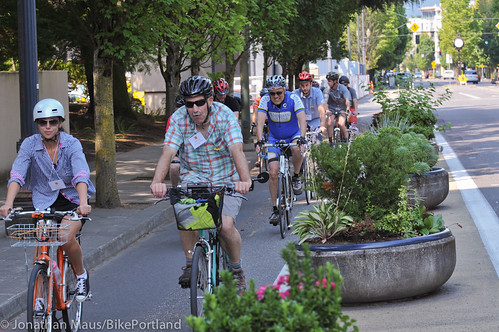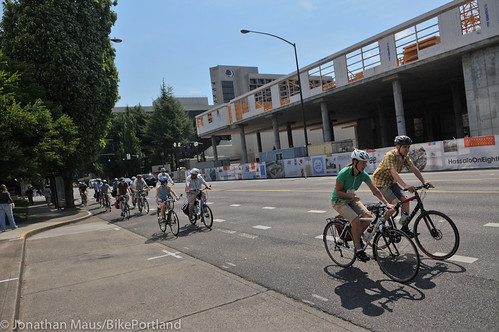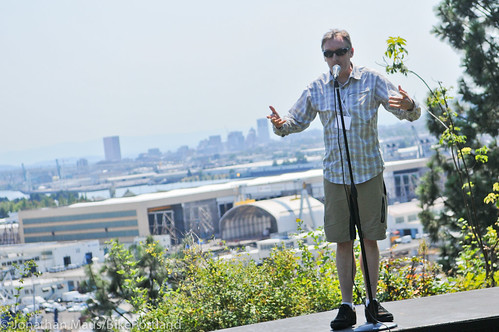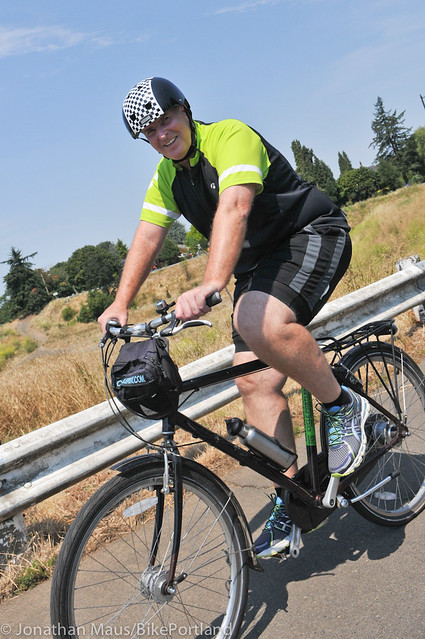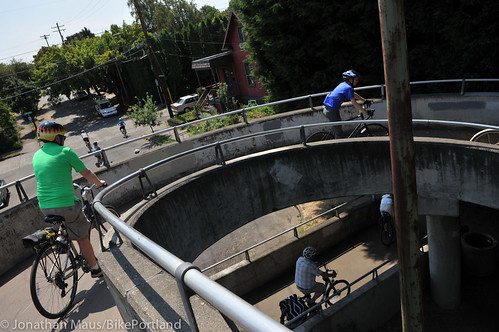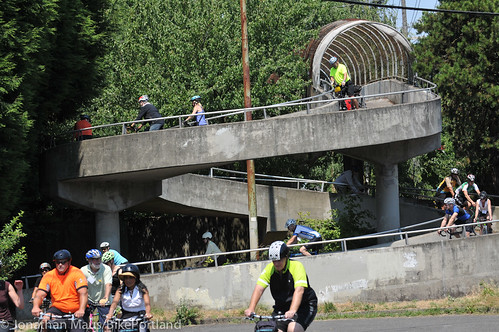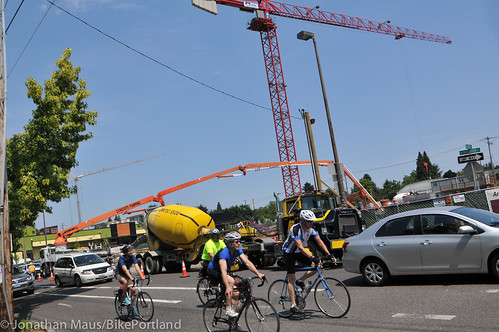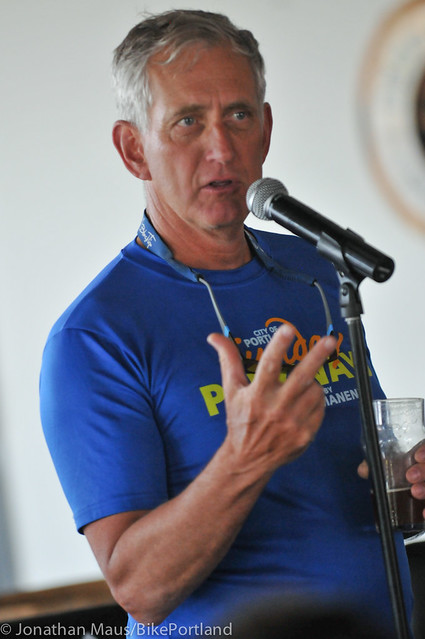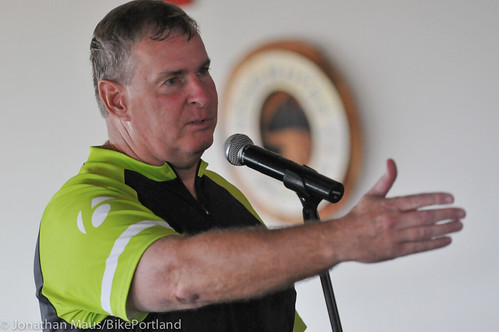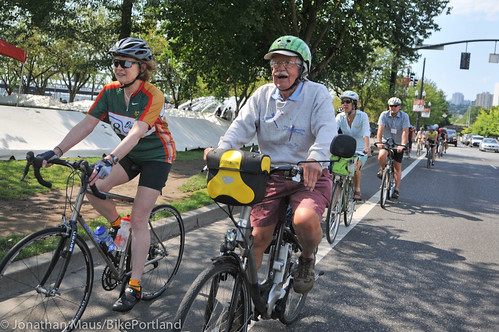
(Photos by J. Maus/BikePortland)
For ten years now there’s been one annual organized ride that might have more impact on biking in the Portland region than any other. It’s not the largest or the most high-profile ride, but it’s list of invitees definitely carries the most clout: I’m talking about the Policymakers Ride.
First held in 2005, the ride was envisioned as a way to hasten the development of a network of bikeways criss-crossing the region. But instead of another stuffy conference with panel discussions and keynote speeches, its founders — urban wildlife advocate Mike Houck and Cycle Oregon pioneer Jonathan Nicholas — figured getting bureaucrats, advocates, academics, elected officials, and other policymakers out of their offices and onto their bikes would be a much more stimulating way to educate and inspire them.
They were right.
I don’t know if you can draw a direct line from the Policymakers Ride to specific projects and progress, but I do know that big things often start with small conversations, and this ride is where many such conversations get started. It’s also one of the only times each year some of these very influential people see bicycling conditions (good, bad, and ugly) first-hand — an imperative step to building political urgency.
Advertisement
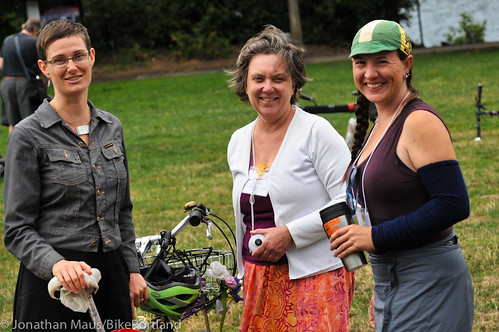
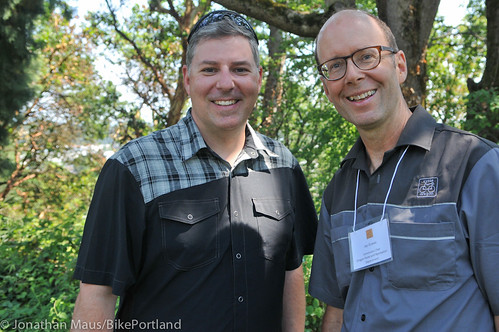
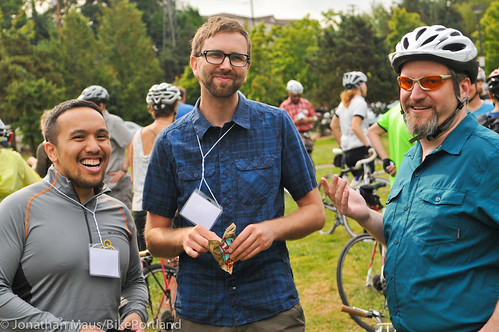
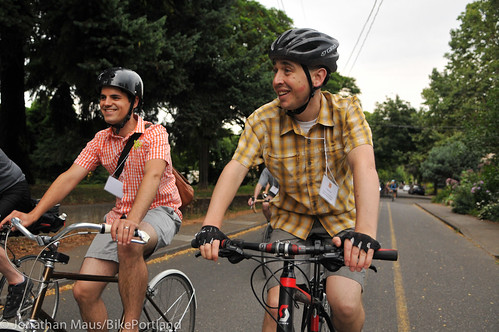
Here are a few other faces I saw in the crowd: Metro council members Shirley Craddick, Kathryn Harrington and Sam Chase; two Portland Planning Commissioners; PBOT Director Leah Treat; Portland City Commissioner Steve Novick Chief of Staff Chris Warner; former Metro Council President David Bragdon; Washington County Commissioner Dick Schouten; and numerous other advocates, city staffers, and planning professionals from around the region.
And then there was Indianapolis Mayor Greg Ballard, invited to Portland (by PBOT bicycle coordinator Roger Geller) specifically to participate in this ride. Ballard became something of a celebrity in the bike world after a keynote speech at the National Bike Summit last year.
Friday’s ride began at the Moda Center where about 150 people gathered to hear opening remarks from the ride organizers. The focus of the day was to experience the good, the bad, and the ugly of local biking conditions and to consider whether some of Portland’s iconic bikeways could become the state’s first urban route to be designated an official “state scenic bikeway.”
From the Rose Quarter Transit Center we rolled along the Willamette down to Sellwood Riverfront Park, then back north along the river to OHSU’s new Collaborative Life Sciences building in South Waterfront.

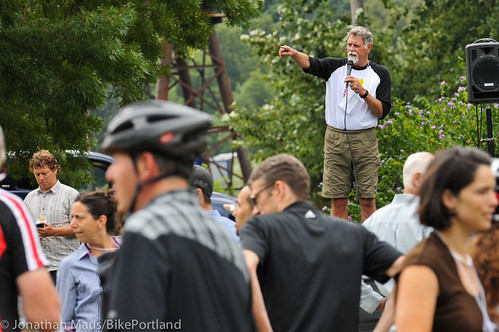
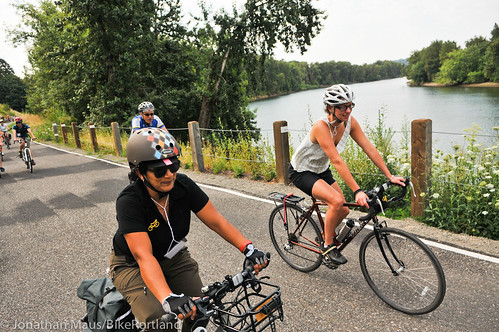
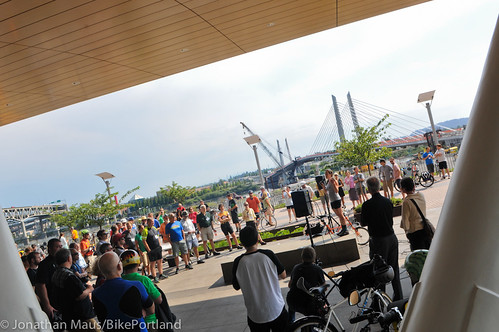
In South Waterfront, we heard from Portland State University President Wim Wiewel. Wiewel kept to a theme that found its way into several speeches: that Portland is resting on its laurels and despite all the cool stuff we’ve done, we need to keep moving forward. He urged assembled leaders to be wary of “Portland disease” that comes with the risk of “staying stymied.” For his part, Wiewel promised to tap into his “Dutch impatience to continue to get things done.”
In the shadow of the new Tillikum Crossing Bridge, we then heard from TriMet Senior Project Manager David Unsworth, who told us the first public access on the bridge will be during Bridge Pedal on August 9, 2015 (news The Oregonian reported a week ago).
From South Waterfront we rode north on Naito and Waterfront Park, across the Steel Bridge deck, then onto the NE Multnomah protected bike lane to Holladay Park.
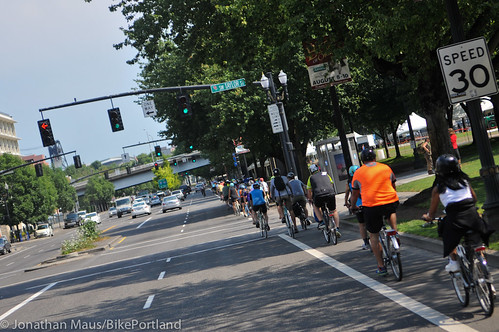
At Holladay Park we heard from Tamara Kennedy-Hill with Travel Portland. She said Portland’s bike infrastructure is one of the agency’s “top brand stories” and that bicycling makes the region a national and international attraction.
Then Kyle Andersen with GBD architects, the firm working on the Hassalo on Eighth project, said the Multnomah Blvd road diet was an “asset to redevelopment” of the Lloyd District. He spoke of a “new paradigm” of development in the area where livability and bike access are taken seriously. Hassalo on Eighth is slated to have 1,200 bike parking spaces. The investors behind the project, he said, came from out of town and “They were surprised to learn bike parking was a requirement, but car parking wasn’t.”
From Holladay Park we headed west to University of Portland via Williams Avenue, Ainsworth, and Willamette.
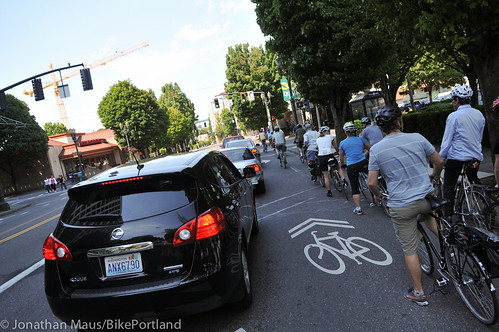
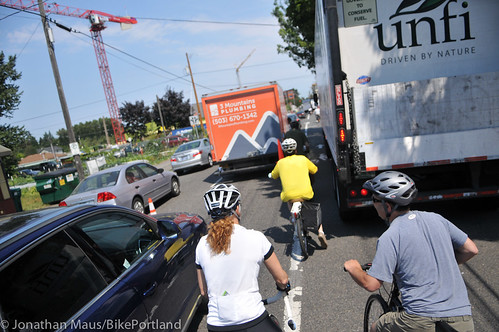
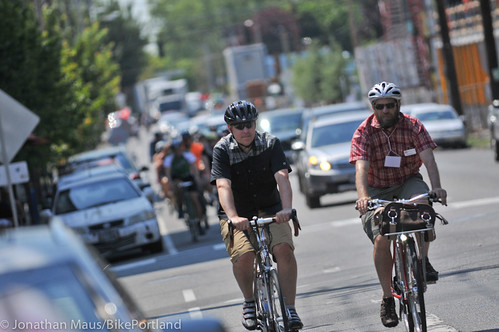
Our stop at University of Portland was on a bluff overlooking Swan Island and northwest Portland. From this vantage point we heard from college Vice President Laurie Kelley who shared her gratitude for the improvements PBOT just made to Willamette Blvd. Kelley said bike access is crucial because of their record-high 1,100 student freshman class, many of whom won’t have cars.
David Bragdon, the former Metro council president, founder of The Intertwine Alliance, and now Executive Director of Transit Center, Inc. in New York City, also took to the stage at U of P. Bragdon urged the crowd to not be afraid of taking risks, and that many great projects began as bold experiments that weren’t part of a long, drawn-out planning process. “Even the first light-rail line,” he recalled, “was a big political risk.” He said people were against the project until the day it opened.
Bragdon said the goal should be to create something that is, “not just a government program, but a movement of the people.”
From U of P we rode back to the Moda Center via Willamette Blvd, the Concord neighborhood greenway, Skidmore, and Vancouver Ave.
Back at the Moda Center at the end of ride, the group was treated to a catered lunch at Jack’s restaurant. Before going on our separate ways, we heard closing remarks from Mayor Hales and Mayor Ballard.
In his speech, Mayor Hales spoke about what he got out of the ride. “This has been a very helpful experience for us as city leaders… To hear the good ideas, to have the good conversations, to talk about the what-ifs.” Then Hales mentioned a new project that illustrates one of these “what-ifs”: “What if we just took that east lane on Naito Parkway and went ahead and made it into a bikeway? You know we really don’t need all those lanes on Naito Parkway.”
After Mayor Hales it was time for the Mayor Ballard to address the crowd.
When Ballard, a Republican and a veteran of the military took office in 2008 (it was a surprise victory in a city of Democrats), there was just one mile of bike lane in Indianapolis. Now there are 82 (including what I think is the most important piece of bicycle infrastructure in the country: the Indianapolis Cultural Trail.) By next year, Ballard hopes to have 200 miles of lanes and paths.
“It’s just common sense,” Ballard, said. “I believe the competition in cities is for talent, and bicycling is a part of that competition for the talent. I’m not doing this stuff because I like to ride bikes, I’m doing this because I’m trying to attract people into the city of Indianapolis.”
Ballard said the Cultural Trail has spurred over $100 million in development so far. “That’s a lot of property taxes,” he said. The trail has spurred not only private investment but it has also helped make the case for more biking and walking paths because planners are seeing the value they bring to the community.
While he touted his cities accomplishments, Ballard was also quick to remind us of our own. “You’re still the model; but people are catching up,” he said, “People still look to you. So get on it!”
Hopefully this powerful peloton of policymakers follows that order.


